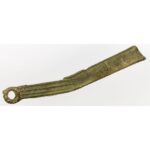Coin in the shape of a bridge
During the two periods of the Eastern Zhou Dynasty (770–256 B.C.), the Spring and Autumn Period (771–476 B.C.) and (in particular) the Warring States Period (475–221 B.C.), bronze money appeared in many forms, mostly miniature replicas of everyday objects such as shovels, knives, bells and other musical instruments, keys, clothes, and other types of weapons and tools. Each state of the fragmented Zhou dynasty territory minted its own money, which is why these coins are often referred to as “state coins” or guobu 國布 in Chinese numismatics. The most common types of coins, and the longest in circulation, were shovel-shaped coins (bubi 布幣 or buqian 布錢) and knife-shaped coins (daobi 刀幣 or daoqian 刀錢).
Rarer were the large coins with an unusual, curved shape, like the one in this photo. It is an example of the so-called “bridge money” or “bridge-shaped coin” (qiaobi ... more
During the two periods of the Eastern Zhou Dynasty (770–256 B.C.), the Spring and Autumn Period (771–476 B.C.) and (in particular) the Warring States Period (475–221 B.C.), bronze money appeared in many forms, mostly miniature replicas of everyday objects such as shovels, knives, bells and other musical instruments, keys, clothes, and other types of weapons and tools. Each state of the fragmented Zhou dynasty territory minted its own money, which is why these coins are often referred to as “state coins” or guobu 國布 in Chinese numismatics. The most common types of coins, and the longest in circulation, were shovel-shaped coins (bubi 布幣 or buqian 布錢) and knife-shaped coins (daobi 刀幣 or daoqian 刀錢).
Rarer were the large coins with an unusual, curved shape, like the one in this photo. It is an example of the so-called “bridge money” or “bridge-shaped coin” (qiaobi 橋幣). In the past, experts in Chinese numismatics believed that it was a form of proto money, that is, the first examples of minted money from the early period of the Zhou Dynasty. Today, most numismatists consider it to be one of the many forms of money from the Warring States Period, dating back to the 4th and 3rd centuries B.C., and it is said to have been minted and used mainly in the Ba 巴 in Shu 蜀 states. (MG)







































Do you have a comment or additional information about the subject?